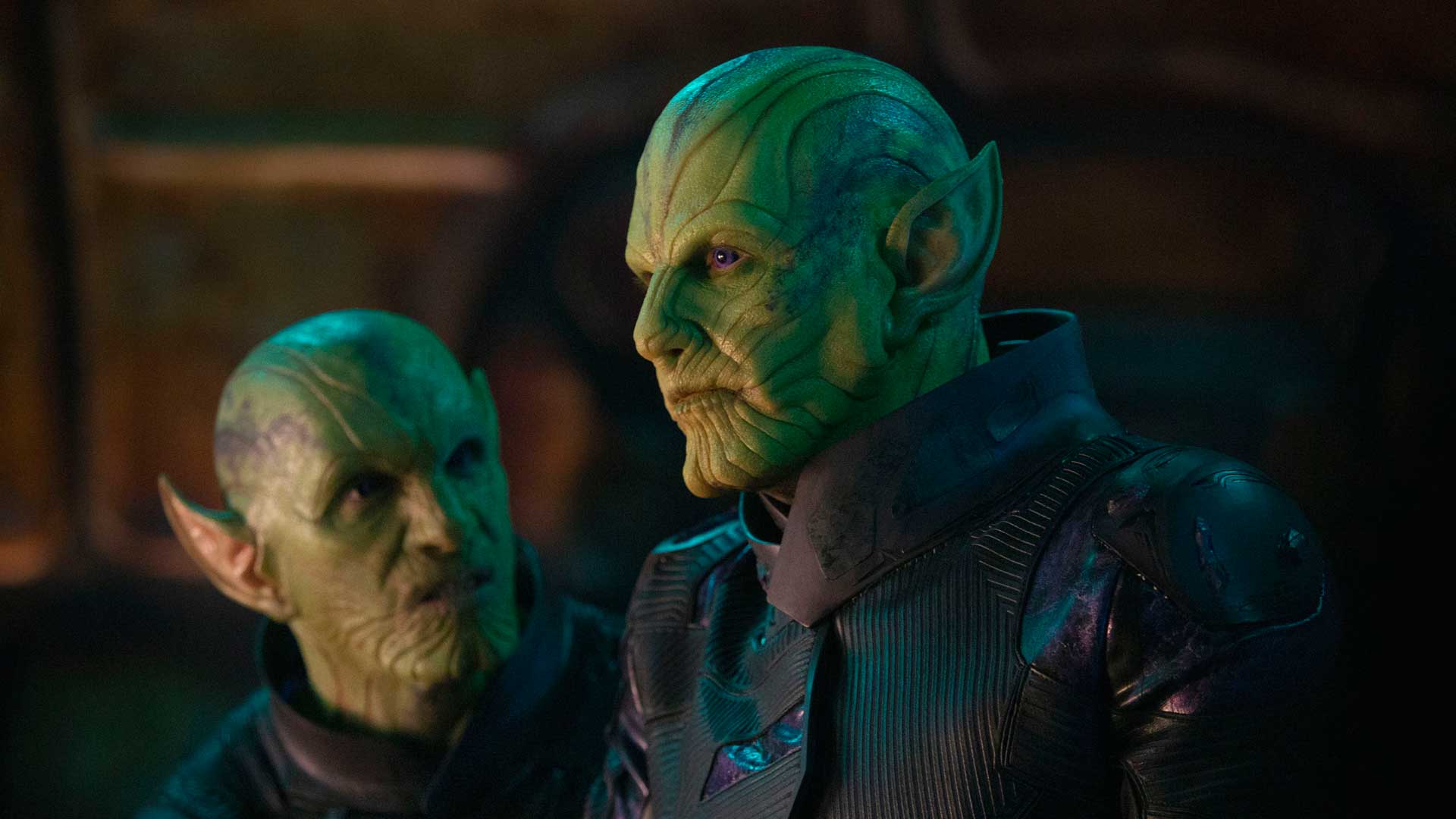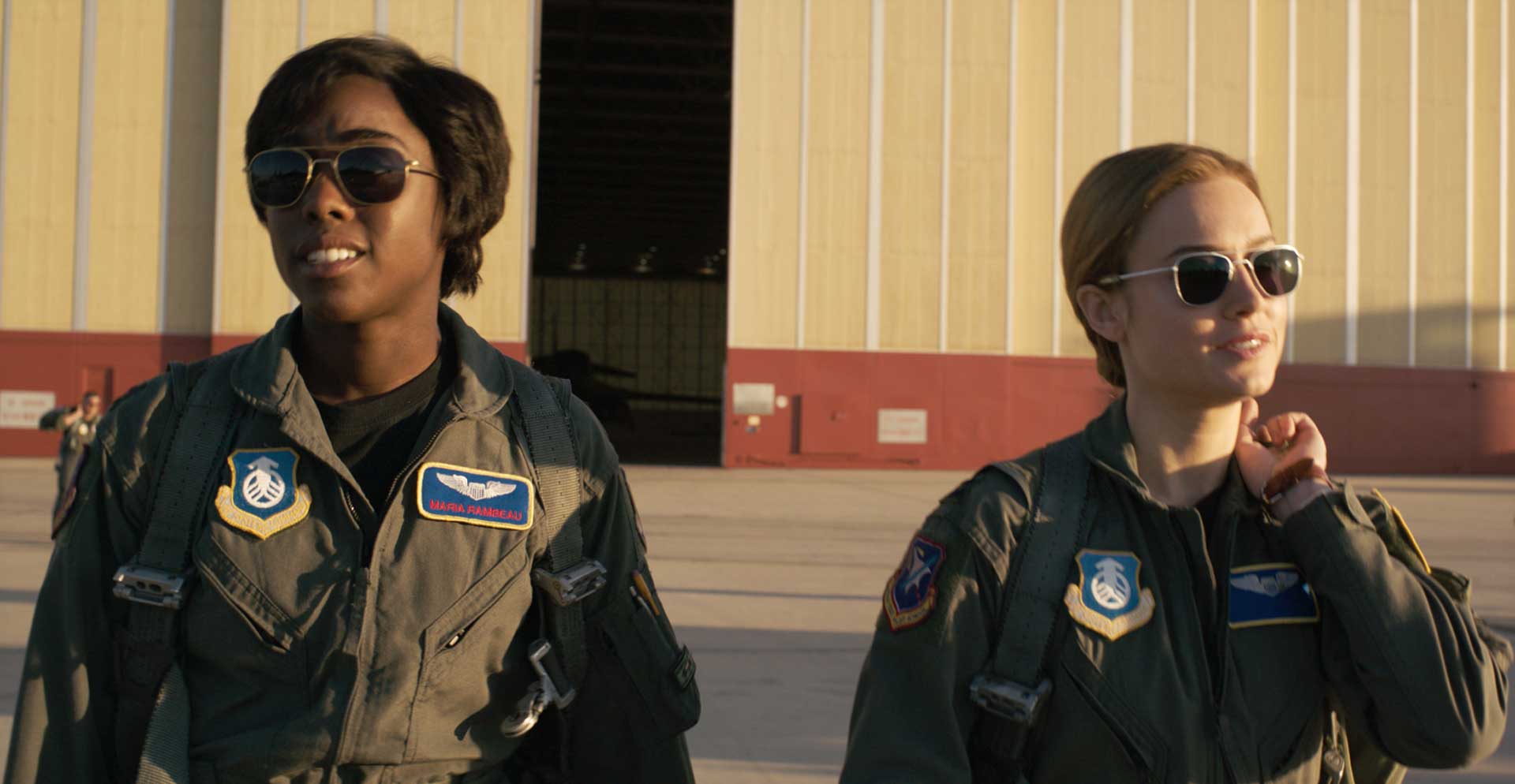When we first see Brie Larson’s Carol Danvers (aside from flashes of her past), we see a fully-formed Kree soldier imbued with powers that she’s struggling to control. Jude Law’s character helps her channel her inner energies in a more restrained, calculated manner. Following that brief prologue, Captain Marvel jumps right in on a Kree mission to rescue one of their spies from an alien planet, with Danvers part of a larger crew dubbed the Starforce. In doing so, Captain Marvel successfully subverts one of the origin story tropes that have consistently plagued both the MCU and the larger pantheon of superhero movies: that the hero in question starts off as a normal person, even a weakling who will gain their powers over the course of the movie. Instead, the “hero” here is operating with their power set intact as flashes into the past will take us through the mystery surrounding the character’s origins.
It’s not the only origin story trope that Captain Marvel tosses away though. Through the movie, we never see Danvers having something even close to a love interest, a problem that Wonder Woman didn’t avoid. Not having a romantic angle shoehorned into the picture allows it to be more about Danvers herself; her character not defined or complete by the presence of another man in her life. And despite throwing a gamut of tried and tested sequences our way, not at once do you cringe at any line, event or its outcome as witnessed by any of the characters. Unlike a lot of recent superhero fare, Captain Marvel plays it straight, utilizing its laughs largely in the context of its 90s setting but keeping things comparatively more serious.
Yet for all its swindling charm and effortlessness, the movie feels tedious, mundane, been-there-done-that and a tad bit predictable down to the very crucial but now customary twist that turns the story on its head (which I will be delving into, so spoiler-phobics beware). It has an assembly line feel to it, and apart from a heartwarming sequence centered around the movie’s middle act, feels like it was made by a committee of producers rather than people with a unique, distinctive vision. The color palette is bland, borrowing on the exact same color grading profile used by most of MCU’s Phase 2 movies, the music despite some promise is generic and the action is edited and choreographed in a manner that makes a lot of it repetitive. And amidst the well-established continuity of the MCU, it appears that directors Anna Boden and Ryan Fleck lose their voice.
Perhaps my biggest gripe with Captain Marvel is that it actually has a strong, well-defined character in Carol Danvers that doesn’t necessarily get the equally well-written moments to shine and emerge. Danvers comes across as a reckless, impatient, free-spirited warrior at heart, often looking to resolve problems quickly by conflict and virtue of her photon blasts. Despite her claims of wanting to end the war, she thrives and enjoys the conflict and relishes blasting through spaceships, the destruction energizing her and supplanting her confidence. It takes a lot to piece all this together though and I’m probably able to do so thanks to the numerous interviews and behind-the-scenes material that I’ve been following about the film’s production. I suppose by writing Danvers’ amnesiac memory into the story, the writers essentially turn her into a blank canvas, which is pretty much what she is for most of the first act, until she meets her earthly friend Maria Rambeau who helps her uncover her past.

You’d think a weak character would at least be supplemented by a strong story but that’s not the case. The beginning of Captain Marvel is spent portraying Skrulls as the villains, looking for access to a Lightspeed tech that will help them travel and colonize to far-off galaxies, with the Kree looking to thwart their attempts. However, mid-way comes the famed twist, that paints the Skrulls as the heroes, actually looking to escape extinction by the hands of Kree, which is fairly acceptable. What’s unacceptable is for the Kree to be after the Tesseract, especially Jude Law’s character (one of the worst kept secrets off late) who really either has no motive to run after the glowing cube, or has an ulterior motive that isn’t clear to me upon first watch. Is it just to stop the Skrulls? Is he answering to someone (most likely) such as the Supreme Intelligence? It’s all left hanging, turning Jude Law into one of the most forgettable villains in MCU history (a real downer after Thanos in Avengers: Infinity War).
That said, there is quite a lot to genuinely enjoy, which brings me to Ben Mendelsohn’s Talos and the Skrull angle. By twisting their villany on its head in an Iron Man 3 inspired move, the filmmakers paint the Skrulls as misunderstood beings branded as terrorists by people who do not understand their ultimately harmless motives. It’s saying something that these hideous looking creatures on the outside are perceived as such on the inside as well, and it’s only a heart-to-heart with Danvers and others that convinces everyone of their true, noble intentions. At the risk of politicizing the narrative, I’d say this somewhat mirrors the refugee crisis with Syria and America in that not everyone seeking asylum is an antagonist looking to mess around. The sequence would never work if either the writing or performance was flat and neither disappoints in this regard. The result is that Talos comes across as a much better character, perhaps even better than Danvers herself and Mendelsohn’s confession and opening up lend the movie its moments of strong heart and emotion that should’ve otherwise belonged to Larson’s Danvers.
The entire sequence at Rambeau’s house is in fact where I believe the directors shine and even truly take over. It has cozy, warm, indie movie vibes with Rambeau and her daughter Monica helping Danvers remember her who she is. Little Monica is awed by the experiences of having two Air-Force pilot women in her life and the twinkle in her eyes when she stares Danvers fly into the sky at the movie’s end isn’t unlike that seen in the children who saw a Wakandan spaceship land in New York at the end of Black Panther. It hammers home the fact that women now have an MCU superhero to look forward to, yet stays subtle enough without really overemphasizing the point. Consequently, the moment comes across as more inspirational than hackneyed and kudos to Marvel for not really pushing the feminist agenda too much and letting the action and sequences speak for themselves.
At this point, Marvel has the technical wizardry down to a fault and it shows. It probably isn’t incorrect to suggest that the MCU movies are so technically good and consistent that they’re uninspiring in that regard. The outer-space sequences as well as the action beats look great, if a tad recycled. Among the generic template shots though, are some genuinely frightening ones such as Carol’s plane crash (filmed from cockpit view) and one which sees Danvers falling down back-facing over the vast expanses of the Nevada desert. These create a visceral thrill further accentuated by the IMAX formatting that’s judiciously used in a plethora of scenes (highly recommend watching Captain Marvel in IMAX 2D or IMAX 3D if you can). But perhaps the biggest technical feat is accomplished by Lola VFX, a small effects house specializing in digitally de-aging characters. They take the herculean task of de-aging Samuel L. Jackson’s Nick Fury by 25 years and not once, not in a single shot, do you feel the effect is out of place. If anything, the effect is so convincing and immersive that it takes Jackson’s tiring, panting body to make you realize that this is an old 70-year old man playing his younger self.

Speaking of Nick Fury, in all earnestness, all we get about him are easter-eggs. Whether it’s his full name, the pager, the Budapest reference, the decision to kickstart the Avenger Initiative or the story behind his eye (Goose the cat is a major presence in the movie by the way, in ways you’re not prepared for), really it’s all just filling in the blanks with a bit of a character work here and there. I did like Jackson’s portrayal of Fury as a jovial, over the top desk-jockey type spy / agent that further helps sell the notion of a hardened Fury that he becomes over the years. I would’ve certainly loved to see some of the hardships he underwent in his job back in the days when he wasn’t the director and couldn’t get things done as easily. Lashana Lynch makes quite a strong impression as Maria Rambeau, as does her on-screen daughter and it looks a lot likely that Marvel is setting up pieces for a Young Avengers movie down the line. In a touching bit, Stan Lee cameos as himself rehearsing lines for his cameo in the 90s film Mallrats and also gets a tribute through the opening credits that greatly signify how less can be more. And even if it was a lot smaller than expected, we get to see Clark Gregg back on screen as Agent Coulson which is a delight I was truly unprepared for.
On the whole, Captain Marvel does have a lot of parts to it preventing it from standing out. That isn’t to deny the parts of it that are appealing enough to warrant a watch at the big screen. It’s large scale, big-budget, blockbuster level filmmaking, technically flawless with some small bits of heart in the middle flanked by relentless action set-pieces, chases and superhero battles. Fortunately, the battles take place in a desert and not in a city. In-universe, that may be to keep Captain Marvel’s existence concealed. In the world of Hollywood though, it’s a breeath of fresh air from seeing another city crumble to dust. After all, how many times can you watch New York be destroyed by heroes fighting in the sky?
Lastly, there’s the matter of the mid-credits and post-credits scenes. While the latter is just played out for laughs, the former is a moment that will get you hyped up for Avengers: Endgame beyond proportion. Suffice to say, as far as credits sequences go, it’s the biggest payoff Marvel has given us in recent times, which is quite saying something. Half-a stars just for this sequence, I guess.





